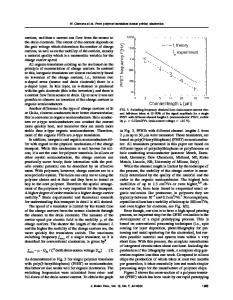Alkyl side chain engineering for difluorinated benzothiadiazole flanked non-fullerene acceptors toward efficient polymer
- PDF / 1,545,194 Bytes
- 13 Pages / 595.276 x 790.866 pts Page_size
- 67 Downloads / 950 Views
Alkyl side chain engineering for difluorinated benzothiadiazole flanked non-fullerene acceptors toward efficient polymer solar cells Mingqing Chen1, Yaowen Nian1, Zelong Hu1, and Lianjie Zhang1,* 1
Institute of Polymer Optoelectronic Materials & Devices, State Key Laboratory of Luminescent Materials & Devices, South China University of Technology, 510640 Guangzhou, P. R. China
Received: 24 August 2020
ABSTRACT
Accepted: 26 October 2020
Side chain engineering plays a vital role in fine tuning of non-fullerene acceptors for the contemporary organic solar cells. In this work, we compare central alkyl side chains in the modification of photophysical and photovoltaic properties of difluorinated benzothiadiazole flanked non-fullerene acceptors. With a hexyl side chain, the resulting non-fullerene H-FFBR possesses more compact intermolecular interaction, leading to narrower bandgap, higher-lying HOMO level and stronger self-aggregation, if compared to O-FFBR with octyl side chain. For the photovoltaic performances, with PTB7-Th as the donor polymer, the O-FFBR-based solar cells exhibit power conversion efficiency of 9.4%, which is higher than that of 9.1% for the H-FFBR-based devices. Bulk-heterojunction morphologies of the O-FFBR- and H-FFBR-based active layers were compared by atomic force microscopy (AFM) and transmission electron microscope (TEM), revealing that O-FFBR is likely to give lower surface roughness and smaller phase separation. Our work demonstrates that varying alkyl side chain of a non-fullerene acceptor is valuable to tune the bulk-heterojunction morphology and resulting photovoltaic performance.
Ó
Springer Science+Business
Media, LLC, part of Springer Nature 2020
1 Introduction Organic solar cells (OSCs), as a promising energy source technology, have attracted extensive attention due to their advantages of low cost, light weight, and potential of large area production via roll-to-roll processing [1–4]. For a long period, fullerene derivatives have been mostly used as acceptors in photoactive bulk heterojunctions which contain electron-donating
Address correspondence to E-mail: [email protected]
https://doi.org/10.1007/s10854-020-04757-x
and electron-accepting materials [5, 6]. However, the accessible power conversion efficiencies (PCEs) of fullerene-based single junction OSCs have been limited to a great extent because fullerene acceptors cannot get well control of absorption spectral region, synthetic and purification procedure, and energy levels [7–13]. In the past five years, non-fullerene acceptors emanate a pronounced role in OSC field, elevating the PCE to a new high level [14–27].
J Mater Sci: Mater Electron
Fused-ring methodology has been explored extensively to flourish the family of fused-ring electron acceptors (FREA) [28–35]. Some representative molecular skeleton units have been widely incorporated as the core unit, such as indacenodithieno[3,2b]thiophene [8] and indacenobis(dithieno[3,2-b; 20 ,30 d]thiophene) [29]. Although the core units of fused ring determine the
Data Loading...











